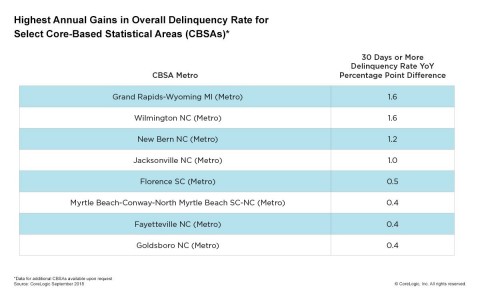- U.S. serious delinquency and foreclosure rates were the lowest for September in 12 years
- The overall past due rate has fallen on a year-over-year basis for the past nine consecutive months
- In the wake of major natural disasters – such as Hurricane Florence, the Carr Fire and the Kilauea eruption – impacted metro areas have experienced an upward spike in delinquency rates
IRVINE, Calif. — (BUSINESS WIRE) — December 11, 2018 — CoreLogic® (NYSE: CLGX), a leading global property information, analytics and data-enabled solutions provider, today released its monthly Loan Performance Insights Report. The report shows that, nationally, 4.4 percent of mortgages were in some stage of delinquency (30 days or more past due, including those in foreclosure) in September 2018, representing a 0.6 percentage point decline in the overall delinquency rate compared with September 2017, when it was 5 percent.
This press release features multimedia. View the full release here: https://www.businesswire.com/news/home/20181211005110/en/

Highest Annual Gains in Overall Delinquency Rate Occurred in Several North and South Carolina Metro Areas; CoreLogic September 2018. (Graphic: Business Wire)
As of September 2018, the foreclosure inventory rate – which measures the share of mortgages in some stage of the foreclosure process – was 0.5 percent, down 0.1 percentage point since September 2017. The September 2018 foreclosure inventory rate tied with the April, May, June, July and August rates this year as the lowest for any month since September 2006, when it was also 0.5 percent.
Measuring early-stage delinquency rates is important for analyzing the health of the mortgage market. To monitor mortgage performance comprehensively, CoreLogic examines all stages of delinquency, as well as transition rates, which indicate the percentage of mortgages moving from one stage of delinquency to the next.
The rate for early-stage delinquencies – defined as 30 to 59 days past due – was 2.2 percent in September 2018, down from 2.4 percent in September 2017. The share of mortgages that were 60 to 89 days past due in September 2018 was 0.7 percent, unchanged from September 2017. The serious delinquency rate – defined as 90 days or more past due, including loans in foreclosure – was 1.5 percent in September 2018, down from 1.9 percent in September 2017, and unchanged from August 2018. This serious delinquency rate was the lowest for September since 2006 when it was 1.4 percent, and was the lowest for any month, prior to August 2018, since it was also 1.5 percent in March 2007.
Since early-stage delinquencies can be volatile, CoreLogic also analyzes transition rates. The share of mortgages that transitioned from current to 30 days past due was 1.2 percent in September 2018, down from 1.3 percent in September 2017. By comparison, in January 2007, just before the start of the financial crisis, the current-to-30-day transition rate was 1.2 percent, while it peaked in November 2008 at 2 percent.
“The effects of 2018’s natural disasters have begun to show clearly in our delinquency data,” said Dr. Frank Nothaft, chief economist for CoreLogic. “After Kilauea’s eruption began in May, serious delinquency rates jumped on the Big Island by 10 percent between June and September, while falling by 4 percent in the rest of Hawaii. The Carr Fire began late July, and the 30- or 60-day delinquency rate in the Redding metro area jumped 19 percent from August to September. This was the largest monthly spike up in this delinquency metric since July 2006 when the foreclosure crisis was beginning. Additionally, 30-day delinquency rates doubled in major metros in North Carolina in September, the first month after Hurricane Florence reached landfall.”
Hurricane Florence caused considerable economic disruption in September this year. Seven of the top eight metro areas that experienced the highest annual gains in the overall delinquency rate were in North Carolina and South Carolina, where the storm had significant impact. In Wilmington, the 30-day delinquency rate jumped from 1.7 percent to 3.8 percent between August and September. Data collected over the next few months will shed more light on the storm’s impact on mortgage payments.
“Outside of areas affected by natural disasters, serious delinquency and foreclosure rates have declined steadily across the nation as the labor market has improved and home prices have risen,” said Frank Martell, president and CEO of CoreLogic. “However, we have also seen a rise in high loan-to-value and high debt-to-income lending in our CoreLogic TrueStandings data, heightening the risk of a significant upturn in loan default if the economy slips into recession or home prices decline.”
For ongoing housing trends and data, visit the CoreLogic Insights Blog: www.corelogic.com/insights.
Methodology
The data in this report represents foreclosure and delinquency activity reported through September 2018.
The data in this report accounts for only first liens against a property
and does not include secondary liens. The delinquency, transition and
foreclosure rates are measured only against homes that have an
outstanding mortgage. Homes without mortgage liens are not typically
subject to foreclosure and are, therefore, excluded from the analysis.
Approximately one-third of homes nationally are owned outright and do
not have a mortgage. CoreLogic has approximately 85 percent coverage of
U.S. foreclosure data.

